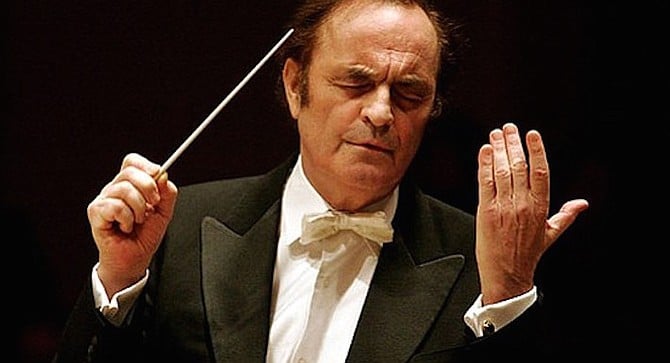 Facebook
Facebook
 X
X
 Instagram
Instagram
 TikTok
TikTok
 Youtube
Youtube

Well, I guess the May 20th concert by the San Diego Symphony was the best one I’ve heard them perform. Yes. I’m going to go with that. Charles Dutoit conducted the living fire out of the orchestra in a concert which stretched from Mozart through Beethoven to Stravinsky and Ravel.
The styles of Beethoven and Mozart were captured to perfection. Obviously these are well-known styles but not often are they so masterfully expressed.
Violinist Simone Porter played Mozart's Violin Concerto No. 3 with a beauty of tone which was equal to the stylistic perfection being pulled out of the orchestra by Dutoit. The famous second movement had just the right amount of suspension and grace.
What happens if a performance gets just the wrong amount? You risk being cheap and saccharin. That might work for — well I was going to bad mouth some other types of music but this concert has elevated my mindset. I need not stoop to such low levels of discourse.
Stravinsky’s Petrushka rocked my world. Holy hell, what a piece of music and what a performance. The audience gave it a mid-concert standing ovation. To my knowledge, that was a first for the San Diego Symphony.
Ravel’s La Valse was the concluding piece in the concert. This is one of my favorite pieces of music and it’s about one of my favorite periods of history, fin de siecle Vienna.
Several people more wise than I have commented on Ravel's take on the waltz. In his book, Fin de Siecle Vienna, Carl Schorske writes:
“At the close of World War I, Maurice Ravel recorded in La Valse about the violent death of the nineteenth-century world. The waltz, long the symbol of gay Vienna, became in the composer's hands a frantic danse macabre.”
Ravel himself said, “I feel this work a kind of apotheosis of the Viennese waltz, linked in my mind with the impression of a fantastic whirl of destiny.”
Several years ago I played this piece of music for my daughter who was seven years old at the time. Her take on Ravel’s music was, “Oh, I’m floating on a cloud of magic. Help! Help! I fell off the cloud.”
One last observation. With a name as famous and venerated as Charles Dutoit, it is tempting to fall into a false sense of value. More than once I’ve observed audiences responding to “a name” instead of the quality of the performance, which was less than great.
In this case I feel that the reality of Dutoit’s conducting exceeded his reputation. I’m guessing the San Diego Symphony might agree with me on that one.


Well, I guess the May 20th concert by the San Diego Symphony was the best one I’ve heard them perform. Yes. I’m going to go with that. Charles Dutoit conducted the living fire out of the orchestra in a concert which stretched from Mozart through Beethoven to Stravinsky and Ravel.
The styles of Beethoven and Mozart were captured to perfection. Obviously these are well-known styles but not often are they so masterfully expressed.
Violinist Simone Porter played Mozart's Violin Concerto No. 3 with a beauty of tone which was equal to the stylistic perfection being pulled out of the orchestra by Dutoit. The famous second movement had just the right amount of suspension and grace.
What happens if a performance gets just the wrong amount? You risk being cheap and saccharin. That might work for — well I was going to bad mouth some other types of music but this concert has elevated my mindset. I need not stoop to such low levels of discourse.
Stravinsky’s Petrushka rocked my world. Holy hell, what a piece of music and what a performance. The audience gave it a mid-concert standing ovation. To my knowledge, that was a first for the San Diego Symphony.
Ravel’s La Valse was the concluding piece in the concert. This is one of my favorite pieces of music and it’s about one of my favorite periods of history, fin de siecle Vienna.
Several people more wise than I have commented on Ravel's take on the waltz. In his book, Fin de Siecle Vienna, Carl Schorske writes:
“At the close of World War I, Maurice Ravel recorded in La Valse about the violent death of the nineteenth-century world. The waltz, long the symbol of gay Vienna, became in the composer's hands a frantic danse macabre.”
Ravel himself said, “I feel this work a kind of apotheosis of the Viennese waltz, linked in my mind with the impression of a fantastic whirl of destiny.”
Several years ago I played this piece of music for my daughter who was seven years old at the time. Her take on Ravel’s music was, “Oh, I’m floating on a cloud of magic. Help! Help! I fell off the cloud.”
One last observation. With a name as famous and venerated as Charles Dutoit, it is tempting to fall into a false sense of value. More than once I’ve observed audiences responding to “a name” instead of the quality of the performance, which was less than great.
In this case I feel that the reality of Dutoit’s conducting exceeded his reputation. I’m guessing the San Diego Symphony might agree with me on that one.
Comments